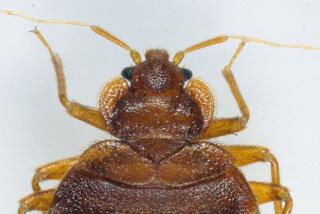A strategy against bedbugs
- Share via
Re “Bedbugs tuck into Southland,” Aug. 13
This story touches on an emerging public health issue -- the overuse and misuse of chemicals to control pests. The conventional response to pest infestations in homes is to spray chemical pesticides. Unfortunately, this can cause health risks to residents, particularly children, and the development of resistant strains of pests, i.e. super bugs.
It is disingenuous to say bedbugs are resurging because we no longer use DDT. Bedbugs have been resistant to DDT for more than 40 years, and recent studies show that these tenacious bugs are growing resistant to pesticide products easily found in retail stores.
Public health and environmental agencies, as well as some pest control companies, have begun promoting a more comprehensive approach called “least-toxic integrated pest management,” which seeks to determine why and how pests are becoming a nuisance and fix the underlying conditions of the problem.
When battling bedbugs, for example, this approach may look something like this: daily vacuuming of the mattress and bedroom furniture; cleaning of bed linens in hot water; moving the bed away from the wall; sealing the crevices in the windows and walls in the bedroom; and, as a last resort, silica gel dusts. This approach has proved to be successful against bedbugs.
Martha Dina Argüello
Los Angeles
The writer is the director of health and environment programs with Physicians for Social Responsibility-Los Angeles.
More to Read
Sign up for Essential California
The most important California stories and recommendations in your inbox every morning.
You may occasionally receive promotional content from the Los Angeles Times.










